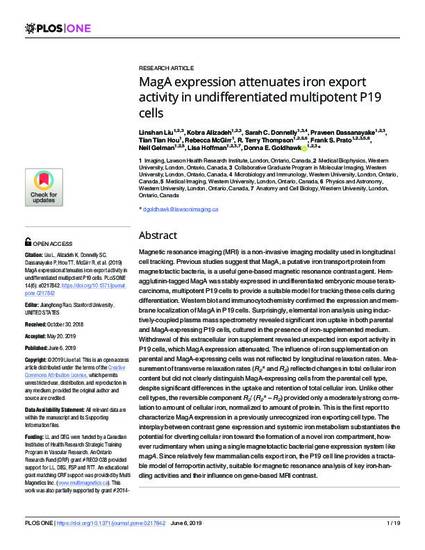
© 2019 Liu et al. This is an open access article distributed under the terms of the Creative Commons Attribution License, which permits unrestricted use, distribution, and reproduction in any medium, provided the original author and source are credited. Magnetic resonance imaging (MRI) is a non-invasive imaging modality used in longitudinal cell tracking. Previous studies suggest that MagA, a putative iron transport protein from magnetotactic bacteria, is a useful gene-based magnetic resonance contrast agent. Hem-agglutinin-tagged MagA was stably expressed in undifferentiated embryonic mouse teratocarcinoma, multipotent P19 cells to provide a suitable model for tracking these cells during differentiation. Western blot and immunocytochemistry confirmed the expression and membrane localization of MagA in P19 cells. Surprisingly, elemental iron analysis using inductively-coupled plasma mass spectrometry revealed significant iron uptake in both parental and MagA-expressing P19 cells, cultured in the presence of iron-supplemented medium. Withdrawal of this extracellular iron supplement revealed unexpected iron export activity in P19 cells, which MagA expression attenuated. The influence of iron supplementation on parental and MagA-expressing cells was not reflected by longitudinal relaxation rates. Measurement of transverse relaxation rates (R2* and R2) reflected changes in total cellular iron content but did not clearly distinguish MagA-expressing cells from the parental cell type, despite significant differences in the uptake and retention of total cellular iron. Unlike other cell types, the reversible component R20 (R2* – R2) provided only a moderately strong correlation to amount of cellular iron, normalized to amount of protein. This is the first report to characterize MagA expression in a previously unrecognized iron exporting cell type. The interplay between contrast gene expression and systemic iron metabolism substantiates the potential for diverting cellular iron toward the formation of a novel iron compartment, however rudimentary when using a single magnetotactic bacterial gene expression system like magA. Since relatively few mammalian cells export iron, the P19 cell line provides a tractable model of ferroportin activity, suitable for magnetic resonance analysis of key iron-handling activities and their influence on gene-based MRI contrast.
Available at: http://works.bepress.com/dr-lisa-hoffman/3/

© 2019 Liu et al. This is an open access article distributed under the terms of the Creative Commons Attribution License, which permits unrestricted use, distribution, and reproduction in any medium, provided the original author and source are credited.
The article was originally published as:
Liu L, Alizadeh K, Donnelly SC, Dassanayake P, Hou TT, McGirr R, et al. (2019) MagA expression attenuates iron export activity in undifferentiated multipotent P19 cells. PLoS ONE 14(6): e0217842. https://doi.org/10.1371/journal.pone.0217842